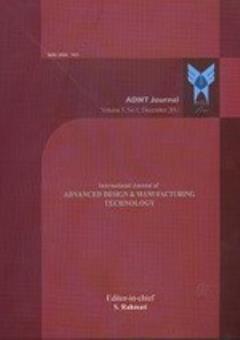The Effect of Boundary Conditions and Concentrated Mass on The Performance and Vibration Results of Piezoelectric Bimorph Beam by Parallel and Series Layers
Subject Areas : Mechanical Engineeringmajid jabbari 1 * , Sofia Jabbari 2
1 - Department of Mechanical Engineering, Khomeinishahr Branch, Islamic Azad University, Khomeinishahr/Isfahan, Iran
2 - Isfahan Healthcare Center, University of Applied Sciences and Technology, Isfahan, Iran
Keywords: Actuator, Finite Element, Frequency, Piezoelectric Beam, Support ,
Abstract :
A variety of parameters influence the performance of piezoelectric sensors and actuators, such as support and concentrated mass. This paper presents a finite element formulation for piezoelectric structures and studies the effect of parameters on them. This method was developed based on the Bernoulli-Euler beam and the model is considered for use as a beam structure using the Variation Principle. The model was used for static and vibration analysis. The effects of support on the deflection of the piezoelectric beam were studied. Modal analysis was also carried out for the electromechanical coupling and uncoupling beams, and the effect of the concentrated mass was deduced. The finite element model was developed with FORTRAN programming Language and was implemented with MATLAB software. A comparison of the results between the analytical method, engineering software, and this program, showed acceptable accuracy.
[1] Allik, H., Hughes, T. J. R., Finite Element Method for Piezoelectric Vibration, International Journal for Numerical Methods in Engineering, Vol. 2, 1970, pp. 151–157.
[2] Zemcik, R., Roifes, R., Rose, M., and Tessmer, J., High Performance Four-node Shell Element with Piezoelectric Coupling for the Analysis of Smart Laminated Structures, Int. J. Numer. Meth. Engng, Vol. 70, 2007, pp. 961-934.
[3] Lazarus, A., Thomas, O., Deu, J. F., Finite Element Reduced Order Models for Nonlinear Vibration of Piezoelectric Layered Beams with Applications to NEMS, Finite Elements in Analysis and Design, Vol. 49, 2012, pp. 51-35.
[4] Kogl, M., Bucalem, M. L., Analysis of Smart Laminates using Piezoelectric MITC Plate and Shell Elements, Computers and Structures, Vol. 83, 2005, pp. 1163-1153.
[5] Piefort, V., Preumont, A., Finite Element Modeling of Smart Piezoelectric Shell Structures, 5th National Congress on Theoretical and Applied Mechanics, 2000.
[6] Sebald, G., Kuwano, H., and Guyomar, D., Experimental Duffing Oscillator for Broadband Piezoelectric Energy Harvesting, Smart Materials and Structures, Vol. 20, 2011, pp. 1–10.
[7] Erturk, A., Inman, D. J., Broadband Piezoelectric Power Generation on High-energy Orbits of the Bistable Duffing Oscillator with Electromechanical Coupling, Journal of Sound and Vibration, Vol. 330, 2011, pp. 2339–2353.
[8] Friswell, M. I., Faruque, S. A., Bilgen, O., Adhikari, S., Lees, A. W., and Litak, G., Non-linear Piezoelectric Vibration Energy Harvesting from a Vertical Cantilever Beam with Tip Mass, Journal of Intelligent Material Systems and Structures, Vol. 23, No. 13, 2012, pp. 1505–1521.
[9] Bendigeri, C., Tomar, R., Basavaraju, S., and Arasukumar, K., Detailed Formulation and Programming Method for Piezoelectric Finite Element, Int. J. Pure Appl. Sci. Technol, Vol. 7, No. 1, 2011, pp. 1-21.
[10] Jabbari, M., Ghayour, M., The Effect of Support and Concentrated Mass on the Performance of Piezoelectric Beam Actuator and Frequencies, ISAV, 2013.
[11] Jabbari, M., Ghayour, M., The Numerical Solution of Dynamic Behavior of Nonlinear Piezoelectric Beam, Aero 2014, Tehran Univercity, 2013.
[12] Jabbari, M., Ghayour, M., and Mirdamadi, H. R., Energy Harvesting of a Multilayer Piezoelectric Beam in Resonance and Off-resonance Cases, Journal of Engineering Materials and Technology, Vol. 139, 2017, pp. 031008-1.
[13] Jabbari M, Ghayour M, Mirdamadi H.R., Experimental and Numerical Results of Dynamics Behavior of a Nonlinear Piezoelectric Beam, Mechanics of Advanced Materials and Structures, Vol 23, No 8, 2016, 853-864.
[14] Jabbari, M., The Effect of Strain Nodes on the Energy Harvesting of the Cantilever Piezoelectric Beam with the Vibration Mode Excitation, Modares Mechanical Engineering, Vol. 17, No. 10, 2018, pp. 65-72.
[15] Jabbari, M., Ahmadi, B., The Electric Response of Piezoelectric Beam Using Dynamic Stiffness Method, Applied and Computational Sciences in Mechanics, Vol, 31, No, 2, 2020.
[16] Hassannejad, R., Hosseini, S. R., and Alizadeh Hamidi, B., Influence of Non-circular Cross Section Shapes on Torsional Vibration of a Micro-rod Based on Modified Couple Stress Theory, Acta Astronautica, Vol. 178, No. 2, 2021, pp. 805-812.
[17] Shameli, R., Aghadavoudi, F., and Hashemian, M., Free Torsional Vibration Analysis of Nanorods with Non-circular Cross-Sections Based on the Second-Order Strain Gradient Theory. J. Vib. Eng. Technol., Vol. 11, 2023, pp. 3039–3055.

